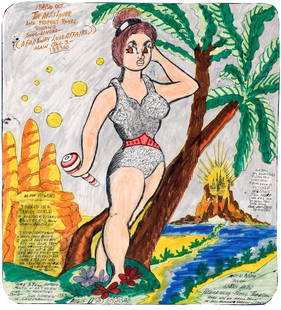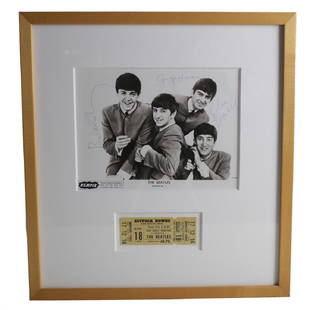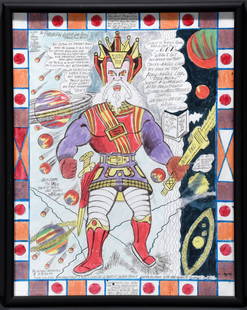
19th C. Russian Royal Door Panels, Museum-Exhibited
Similar Sale History
View More Items in Movie & TV MemorabiliaRelated Movie & TV Memorabilia
More Items in Movie & TV Memorabilia
View MoreRecommended Entertainment Memorabilia
View More











Item Details
Description
Russia, ca. 1890 CE. A pair of arched wood Royal Door wing panels for an iconostasis or icon screen within an Orthodox church, finely finished in egg tempera and gold leaf, displaying an Annunciation scene in the upper register with depictions of the Four Evangelists below, traditional iconography of Royal Doors. The gold background is ornately incised with an intricate floral pattern and the borders are decorated with enameled blooming foliage of pink, blue, green, ochre, and red hues. At the top are a pair of mounted silver-gilt six-winged seraphim. Size: 16.25" W x 53" H (41.3 cm x 134.6 cm)
The central doors of an iconostasis are called the Royal Doors. These doors are regarded as sacred and usually kept closed. It is only during the Divine Liturgy that the priest opens them to access the sanctuary (or bema) in order to consecrate the bread and wine. The Gospel is traditionally proclaimed from the Royal doors, and the priest carries the chalice with the body and blood of Christ through the Royal Doors of an iconostasis. Hence, the Royal Doors serve as symbolic point of entry and exit for the Word of God. For these reasons, the Royal Doors have traditionally been decorated with an icon of the Annunciation (displaying the Word of God in the form of Jesus) and/or images of the Four Evangelists (representing the written word of God)
Each of the Evangelists is depicted half-length, seated in his scriptorium, writing his Gospel. One can imagine them surrounded by shelves for volumes and scrolls, parchments, quills, erasing knives, and inks. Images of the evangelists derived from miniatures of illuminated Gospel books and Gospel lectionaries showing them at work in their scriptoria. These portrayals were oftentimes painted on the outside of the Royal Doors as we see here.
The writings of Matthew are typically shown to be inspired by an angel, or after the 14th century, by Sophia Wisdom, the wingless female figure with a scepter and crowned by a double star halo. The Church Fathers assigned each evangelist one of the four living creatures of the Apocalypse, and Matthew’s symbol was the “son of man” since his writings begin with the human genealogy of Christ. According to Irenaeus of Lyon, “The Word of God made its home among men and became the Son of Man to accustom man to understanding God, and to accustom God to making His home among men.”
Saint Luke is also known as Luke the Painter, because as the author of the “Gospel of Jesus’s Childhood” he is believed to have been the first artist to portray Mary with the Christ Child. This understanding is based upon ancient icons from Thebes and Antioch attributed to the evangelist, later transferred to Russia and Constantinople. As the first to paint the Theotokos (Mother of God), Luke’s icons include the Hodegetria of the Constantinople Church of the Blachernae, which legend tells us restored the eyesight of two blind men – hence, the name Hodegetria meaning, “She who gives sight” or “shows the way” – as well as the Virgin of Smolensk, a prototype for numerous Marian icons that came to Russia in the 12th century. Luke’s symbol is the ox or calf, because his Gospel begins with a sacrifice that Zechariah (John the Baptist’s father) made.
Saint John’s symbol is the eagle, chosen for the “sublime manner in which he described the godliness of the Word” according to Christian iconography expert Alfredo Tradigo, who writes, “of all the evangelists, he flew the highest.” (Tradigo, "Icons and Saints of the Eastern Orthodox Church" Getty Museum, 2006, p. 262) Also known as John the Theologian for his ability to channel divine wisdom, Saint John wrote the fourth Gospel (the Book of Revelation), while living in a cave on the isle of Patmos, exiled by Emperor Trajan. There he dictated a dramatic vision of the Apocalypse to the deacon Prochorus, his disciple and steadfast companion. John also wrote the “Gospel of Love” or the “flower of the Gospel” as Origen calls it – in addition to three of the Catholic Epistles. In the words of Patriarch Athenagoras, “John is the source of our loftiest spirituality. Like him, those who are silent know the mysterious confusion that can assail the heart; invoking the presence of John, their hearts catch fire.” (Tradigo, 262)
Finally, Saint Mark is identified with the winged lion, because his Gospel begins with the figure of John the Baptist, man of the desert. Mark was regarded as an astute chronicler, and being well-versed in Latin, accompanied the apostle Paul to Rome where he served as his interpreter.
Above the Evangelists are the Archangel Gabriel holding his attribute, a white lily, messenger of God, the angel of the Nativity and the angel who announced Christ's resurrection; however, Gabriel is best known as the angel of the Annunciation, in which he appears before the Virgin Mary, featured on the pendant door panel, to foretell the birth of Jesus.
Exhibited in "Windows Into Heaven: Russian Icons from the Lilly and Francis Robicsek Collection of Religious Art" at the Mint Museum of Art, Charlotte, North Carolina (December 20, 2003 through February 22, 2004) and the North Carolina Museum of History (October 4, 2013 through March 5, 2014) which presented highlights of one of the world's great artistic traditions through an extraordinary group of sixty-five 18th and 19th century Russian icons on loan from the private collection of Lilly and Francis Robicsek. Published in the catalogue accompanying the North Carolina Museum of History written and compiled by curator Jeanne Marie Warzeski.
Icons (icon means "image" in Greek) are sacred objects within the Eastern Orthodox Christian tradition. Found in homes as well as churches, these painted images depict holy persons and saints as well as illustrate scenes from the Scriptures. Some icons are encased in precious metal covers (oklads) adorned with pearls and semi-precious stones or glass-fronted wooden cases (kiots). Icons are not worshiped, but are instead venerated for their ability to focus the power of an individual's prayer to God. As such they are truly "windows into heaven."
The “Windows Into Heaven” exhibition profiled a magnificent chapter of Russian artistry, the embrace of the Russian Orthodox faith of religious icons during the Romanov centuries. The Russian religious faith was an offshoot of Byzantine Christianity, which in 1054 parted ways from Roman Catholicism. Icons were and continue to be religious images created for veneration. As a focus for prayers and meditation for believers, icons serve as “windows into heaven.”
Provenance: Ex-Francis & Lilly Robicsek Collection, Charlotte, NC, part of the Museum Exhibition, Windows into Heaven - Russian Icons from the Lilly and Francis Robicsek Collection of Religious Art, North Carolina Museum of History
All items legal to buy/sell under U.S. Statute covering cultural patrimony Code 2600, CHAPTER 14, and are guaranteed to be as described or your money back.
A Certificate of Authenticity will accompany all winning bids.
We ship worldwide to most countries and handle all shipping in-house for your convenience.
#119613
The central doors of an iconostasis are called the Royal Doors. These doors are regarded as sacred and usually kept closed. It is only during the Divine Liturgy that the priest opens them to access the sanctuary (or bema) in order to consecrate the bread and wine. The Gospel is traditionally proclaimed from the Royal doors, and the priest carries the chalice with the body and blood of Christ through the Royal Doors of an iconostasis. Hence, the Royal Doors serve as symbolic point of entry and exit for the Word of God. For these reasons, the Royal Doors have traditionally been decorated with an icon of the Annunciation (displaying the Word of God in the form of Jesus) and/or images of the Four Evangelists (representing the written word of God)
Each of the Evangelists is depicted half-length, seated in his scriptorium, writing his Gospel. One can imagine them surrounded by shelves for volumes and scrolls, parchments, quills, erasing knives, and inks. Images of the evangelists derived from miniatures of illuminated Gospel books and Gospel lectionaries showing them at work in their scriptoria. These portrayals were oftentimes painted on the outside of the Royal Doors as we see here.
The writings of Matthew are typically shown to be inspired by an angel, or after the 14th century, by Sophia Wisdom, the wingless female figure with a scepter and crowned by a double star halo. The Church Fathers assigned each evangelist one of the four living creatures of the Apocalypse, and Matthew’s symbol was the “son of man” since his writings begin with the human genealogy of Christ. According to Irenaeus of Lyon, “The Word of God made its home among men and became the Son of Man to accustom man to understanding God, and to accustom God to making His home among men.”
Saint Luke is also known as Luke the Painter, because as the author of the “Gospel of Jesus’s Childhood” he is believed to have been the first artist to portray Mary with the Christ Child. This understanding is based upon ancient icons from Thebes and Antioch attributed to the evangelist, later transferred to Russia and Constantinople. As the first to paint the Theotokos (Mother of God), Luke’s icons include the Hodegetria of the Constantinople Church of the Blachernae, which legend tells us restored the eyesight of two blind men – hence, the name Hodegetria meaning, “She who gives sight” or “shows the way” – as well as the Virgin of Smolensk, a prototype for numerous Marian icons that came to Russia in the 12th century. Luke’s symbol is the ox or calf, because his Gospel begins with a sacrifice that Zechariah (John the Baptist’s father) made.
Saint John’s symbol is the eagle, chosen for the “sublime manner in which he described the godliness of the Word” according to Christian iconography expert Alfredo Tradigo, who writes, “of all the evangelists, he flew the highest.” (Tradigo, "Icons and Saints of the Eastern Orthodox Church" Getty Museum, 2006, p. 262) Also known as John the Theologian for his ability to channel divine wisdom, Saint John wrote the fourth Gospel (the Book of Revelation), while living in a cave on the isle of Patmos, exiled by Emperor Trajan. There he dictated a dramatic vision of the Apocalypse to the deacon Prochorus, his disciple and steadfast companion. John also wrote the “Gospel of Love” or the “flower of the Gospel” as Origen calls it – in addition to three of the Catholic Epistles. In the words of Patriarch Athenagoras, “John is the source of our loftiest spirituality. Like him, those who are silent know the mysterious confusion that can assail the heart; invoking the presence of John, their hearts catch fire.” (Tradigo, 262)
Finally, Saint Mark is identified with the winged lion, because his Gospel begins with the figure of John the Baptist, man of the desert. Mark was regarded as an astute chronicler, and being well-versed in Latin, accompanied the apostle Paul to Rome where he served as his interpreter.
Above the Evangelists are the Archangel Gabriel holding his attribute, a white lily, messenger of God, the angel of the Nativity and the angel who announced Christ's resurrection; however, Gabriel is best known as the angel of the Annunciation, in which he appears before the Virgin Mary, featured on the pendant door panel, to foretell the birth of Jesus.
Exhibited in "Windows Into Heaven: Russian Icons from the Lilly and Francis Robicsek Collection of Religious Art" at the Mint Museum of Art, Charlotte, North Carolina (December 20, 2003 through February 22, 2004) and the North Carolina Museum of History (October 4, 2013 through March 5, 2014) which presented highlights of one of the world's great artistic traditions through an extraordinary group of sixty-five 18th and 19th century Russian icons on loan from the private collection of Lilly and Francis Robicsek. Published in the catalogue accompanying the North Carolina Museum of History written and compiled by curator Jeanne Marie Warzeski.
Icons (icon means "image" in Greek) are sacred objects within the Eastern Orthodox Christian tradition. Found in homes as well as churches, these painted images depict holy persons and saints as well as illustrate scenes from the Scriptures. Some icons are encased in precious metal covers (oklads) adorned with pearls and semi-precious stones or glass-fronted wooden cases (kiots). Icons are not worshiped, but are instead venerated for their ability to focus the power of an individual's prayer to God. As such they are truly "windows into heaven."
The “Windows Into Heaven” exhibition profiled a magnificent chapter of Russian artistry, the embrace of the Russian Orthodox faith of religious icons during the Romanov centuries. The Russian religious faith was an offshoot of Byzantine Christianity, which in 1054 parted ways from Roman Catholicism. Icons were and continue to be religious images created for veneration. As a focus for prayers and meditation for believers, icons serve as “windows into heaven.”
Provenance: Ex-Francis & Lilly Robicsek Collection, Charlotte, NC, part of the Museum Exhibition, Windows into Heaven - Russian Icons from the Lilly and Francis Robicsek Collection of Religious Art, North Carolina Museum of History
All items legal to buy/sell under U.S. Statute covering cultural patrimony Code 2600, CHAPTER 14, and are guaranteed to be as described or your money back.
A Certificate of Authenticity will accompany all winning bids.
We ship worldwide to most countries and handle all shipping in-house for your convenience.
#119613
Condition
Back slats missing as shown. Age cracks and surface fissures and losses to pigment and gold leaf as shown. Seraphim intact with minor surface wear. Wires for suspension on verso.
Buyer's Premium
- 24.5%
19th C. Russian Royal Door Panels, Museum-Exhibited
Estimate $60,000 - $90,000
5 bidders are watching this item.
Get approved to bid.
Shipping & Pickup Options
Item located in Louisville, CO, usSee Policy for Shipping
Payment

Related Searches
TOP





































































